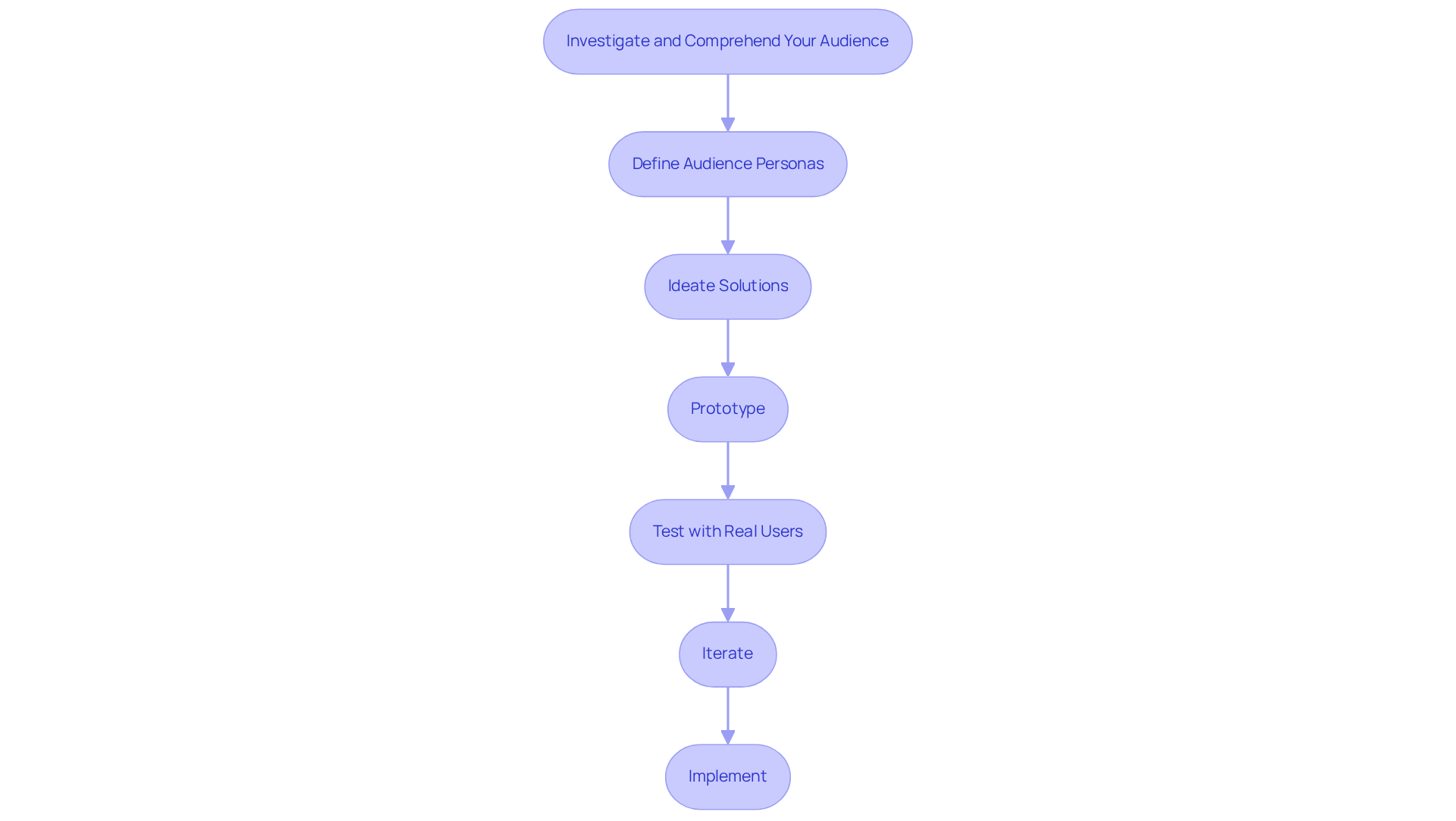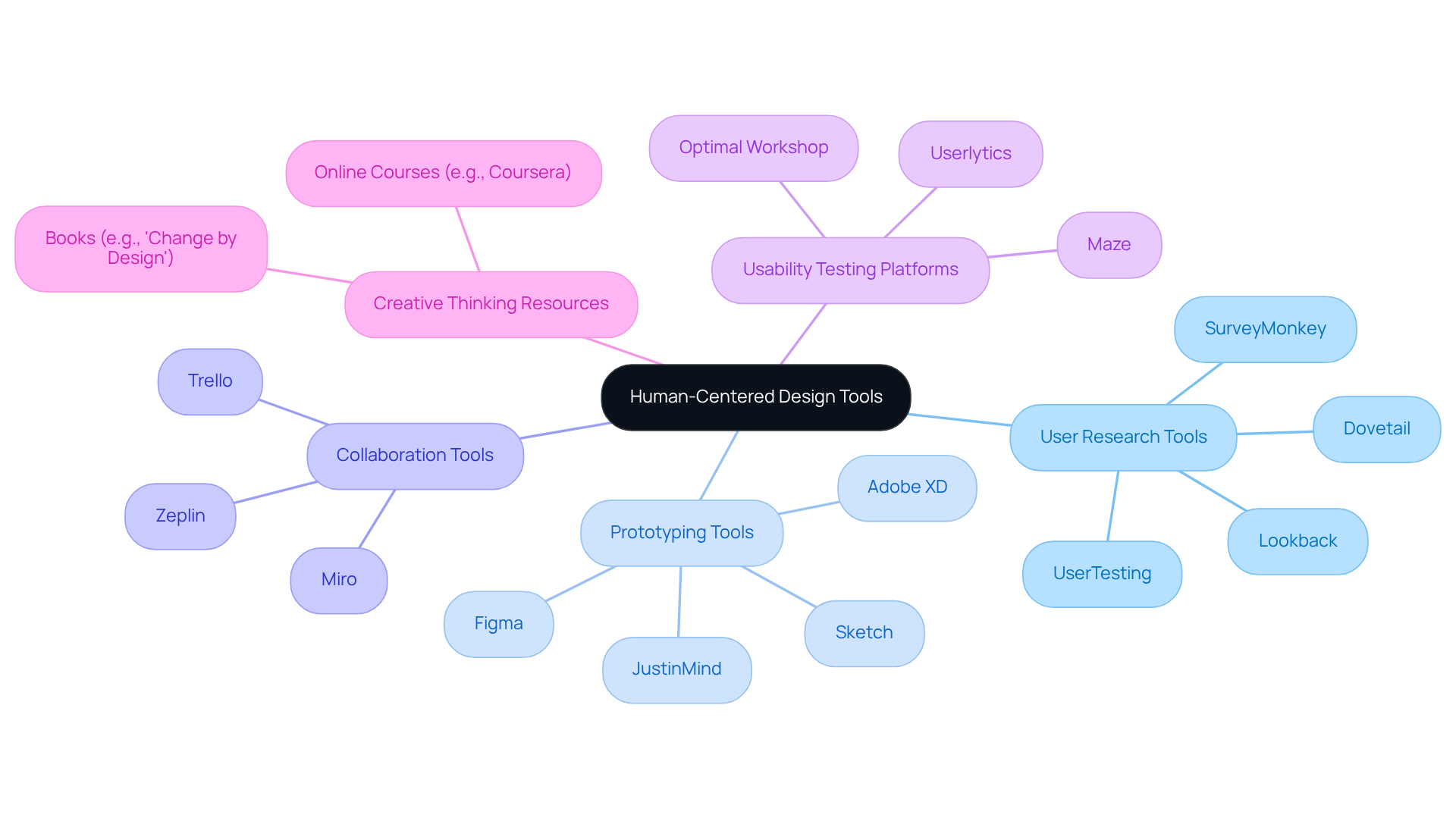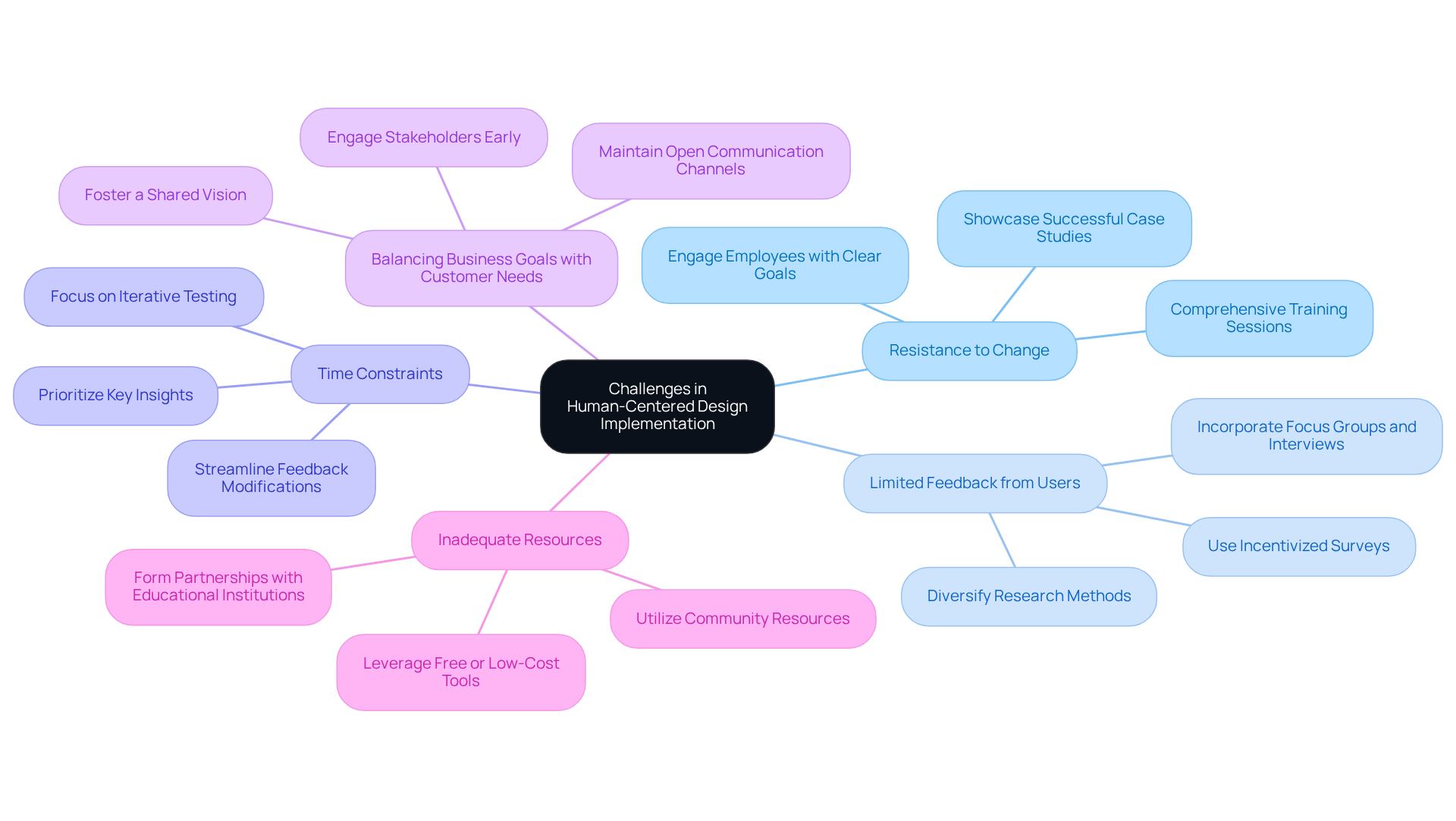Overview
The article highlights a significant challenge faced by tech startups: the need to create products that truly resonate with users. Many founders grapple with the pressure to innovate while ensuring their offerings are user-friendly and effective. This is where human-centered design (HCD) comes into play, serving as a compassionate approach to product development.
By focusing on:
- Understanding the audience
- Prototyping
- Testing
HCD not only addresses these concerns but also fosters a deeper connection with users. Evidence shows that when tech startups embrace these principles, they experience heightened customer satisfaction and business success. This structured approach to HCD is not merely a strategy; it’s a nurturing pathway that empowers founders to create meaningful solutions that genuinely meet the needs of their users.
Introduction
Embracing a human-centered design (HCD) approach is no longer merely an option for tech startups; it has become a critical necessity in a landscape where user experience dictates success. The challenge many founders face is the overwhelming pressure to create products that not only function well but also resonate on a personal level. This can lead to feelings of frustration and uncertainty.
By focusing on the needs and behaviors of individuals, startups can cultivate products that foster innovation and build customer loyalty. Yet, the journey to implementing HCD is fraught with challenges.
How can startups effectively navigate these obstacles to truly connect with their audience? This guide delves into the steps, tools, and strategies essential for overcoming common hurdles, offering a compassionate roadmap to achieving successful human-centered design implementation. Together, we can explore the path forward, ensuring that your vision aligns with the heartfelt needs of your users.
Define Human-Centered Design and Its Importance in Tech Startups
The (HCD) is a strategic approach that prioritizes the needs, preferences, and behaviors of individuals in the creation process. For , embracing a is not just beneficial; it is essential. This approach ensures that products are not only functional but also intuitive and enjoyable to use. In partnership with Figure, RNO1 is transforming compensation management by streamlining practices and effectively conveying total rewards to employees from a human-centered perspective. This includes deliverables like moodboarding, design strategy, and UX/UI design, all crucial for . By prioritizing client experience, startups can create solutions that genuinely address real-world challenges, leading to enhanced customer satisfaction and loyalty. Research indicates that organizations employing usability testing during development face 50% fewer post-launch issues, underscoring the importance of feedback in refining products.
The impact of extends beyond mere functionality; it fosters innovation by encouraging teams to deeply understand individuals and adapt their approaches based on these insights. A survey revealed that 76% of organizations recognize the significance of human-centered software design, which is driven by evolving client expectations and a commitment to accessibility. This shift is particularly vital for tech startups, as 70% of consumers prefer when navigating complex issues, highlighting the necessity for products that resonate with individuals on a personal level.
Case studies further illustrate the advantages of HCD. For instance, a project with the Scottish Government engaged over 2,400 stakeholders to uncover diverse client needs, culminating in a service that significantly boosted satisfaction. Additionally, companies prioritizing consumer research report higher satisfaction rates, with 63% of respondents noting improved customer appeal as a key benefit of applying HCD principles.
In conclusion, the [human-centered approach](https://merative.com/blog/human-centered-design-solves-business-problems) to design transcends being just a methodology; it serves as a pivotal driver of success for tech startups. By focusing on to feedback, RNO1 and Figure can craft exceptional products that not only meet market demands but also cultivate lasting customer relationships.

Outline the Steps to Implement Human-Centered Design
- Investigate and Comprehend Your Audience: Begin your journey by engaging in interviews, surveys, and observations to . , preferences, and behaviors is essential, especially when 55% of companies report a growing need for consumer insights. This foundational knowledge will not only inform your design decisions but also empower you to connect with your audience on a deeper level.
- : Craft detailed personas that capture the essence of your target demographic's characteristics, objectives, and challenges. Well-researched personas serve as that evolve over time, helping align your team's understanding of client needs. This alignment fosters improved communication within design groups, ensuring everyone is on the same page as you work towards a common goal.
- Ideate Solutions: Gather your team and brainstorm potential solutions that address the needs you've identified. Encourage creativity and explore various perspectives, as this collaborative approach can lead to innovative concepts that resonate with your audience. Remember, every idea counts, and your collective insights can spark something truly special.
- Prototype: Bring your ideas to life by developing low-fidelity prototypes, such as sketches, wireframes, or digital mockups. These visual representations allow you to explore concepts and facilitate discussions about the creative direction. They are stepping stones towards understanding how your ideas can best serve your audience.
- : Engage in usability testing with your prototypes to gather invaluable feedback on what works and what doesn’t. Observing how individuals interact with your creations is crucial, as research shows that testing can reveal up to 85% of usability issues. This step is about listening to your users and making adjustments that enhance their experience.
- Iterate: Use the feedback from testing to refine your creations. This iterative process is essential for honing in on the best solutions that meet user needs, ensuring that your final product is not only user-centered but also effective in addressing their challenges.
- Implement: Once you have a validated blueprint, move forward with development. Ensure that the final product reflects the insights gained during the . A strong UX strategy has the potential to elevate conversion rates by up to 400%, demonstrating the impact of truly understanding and meeting your users' needs.

Identify Tools and Resources for Effective Implementation
To effectively implement a in design, tech startups often encounter challenges that can feel overwhelming. However, by leveraging a variety of tools and resources, they can enhance user engagement and streamline the design process. This approach reflects RNO1's , which is dedicated to providing human-centered support to startups on their journey.
: Platforms like UserTesting and SurveyMonkey are invaluable for gathering user feedback and insights. has proven crucial for startups in understanding client needs, leading to greater customer retention and enhanced satisfaction. Remarkably, for every dollar spent on UX, businesses see a $100 return, resulting in a staggering 9,900% ROI. This aligns with , ensuring measurable success through collaborative strategies.
: Tools such as Figma, Sketch, and Adobe XD facilitate the development of interactive prototypes that can be evaluated with users. Figma, in particular, supports over 4 million individuals and is favored for its collaborative features, enabling teams to work together in real-time. In fact, 90% of designers reported using Figma, highlighting its popularity and effectiveness among tech startups. This collaborative spirit mirrors in branding and digital growth.
Collaboration Tools: Miro and Trello foster team cooperation and brainstorming sessions, ensuring that all stakeholders can contribute effectively to the development process. This approach reflects RNO1's dedication to empowering brands through human-centered strategies.
Usability Testing Platforms: Consider utilizing Lookback or Optimal Workshop to conduct usability tests and analyze interactions. These platforms provide insights into consumer behavior, which is essential for enhancing product features. The case study of UserTesting illustrates how gathering user feedback has led to higher customer retention and improved client satisfaction for startups, reinforcing RNO1's focus on delivering measurable success.
: Books like "Change by Design" by Tim Brown and online courses on platforms such as Coursera provide deeper insights into human-centered design concepts, equipping teams with the knowledge to innovate effectively. RNO1's collaboration with Figure exemplifies how such knowledge can transform compensation management into a more human-centered approach.
By utilizing these tools and resources, tech startups can improve their creation processes, ensuring they develop products that resonate with individuals and satisfy market demands. As , their expertise in not only enhances user engagement but also drives conversion rates—mobile application conversion rates are three times higher than those of mobile websites. Moreover, with projections suggesting that 82% of internet traffic will come from video content by 2025, the urgency for engaging digital experiences has never been more pressing. Together, we can navigate these challenges and create meaningful connections with users.

Troubleshoot Common Challenges in Human-Centered Design Implementation
Implementing a approach can present several challenges that may feel overwhelming. It's important to recognize these common issues and explore effective strategies to navigate them together:
- : Many team members may find comfort in traditional design methods, leading to hesitance in embracing HCD principles. To ease this transition, consider investing in that not only highlight the benefits of human-centered design but also showcase from similar organizations. By engaging employees with clear goals and consistent messaging, you can foster a sense of ownership and boost buy-in by up to 85%.
- : A lack of feedback can feel like a significant barrier in the design process. To address this, diversify your research methods by incorporating focus groups, interviews, and incentivized surveys that encourage participation. This inclusive approach can significantly enhance the quality of insights gathered, making everyone feel valued in the process.
- Time Constraints: HCD can sometimes be perceived as a time-consuming endeavor, which may deter teams from fully committing. To streamline efforts, prioritize key insights from users and focus on . This allows for quicker modifications based on feedback, ultimately conserving time in the long run and making the process feel more manageable.
- : It’s essential to align customer requirements with business objectives. Engaging stakeholders early in the planning phase and maintaining open channels of communication can ensure that both client and business goals are met. This collaborative approach fosters a shared vision, reducing friction and creating a supportive environment.
- Inadequate Resources: can feel daunting when trying to implement HCD effectively. However, there are ways to overcome this challenge. Leverage free or low-cost tools and platforms for research and prototyping. Additionally, forming partnerships with educational institutions or utilizing community resources can enhance your capabilities without a significant financial burden.
By proactively addressing these challenges, tech startups can successfully embrace a human-centered approach to design, leading to and enhanced product outcomes. Remember, you are not alone in this journey—support is available, and together, we can create meaningful solutions.

Conclusion
Embracing a human-centered design approach is essential for tech startups seeking to create products that truly resonate with users. Many founders face the challenge of developing technology that feels disconnected from the very individuals it aims to serve. This disconnect can lead to frustration for both the creators and the users, ultimately hindering innovation and customer loyalty. By prioritizing the needs and preferences of individuals, startups can significantly enhance their offerings and foster lasting relationships with their clientele.
The article outlines vital steps for implementing human-centered design:
- Understanding the audience through research
- Moving to prototyping
- Conducting usability testing
Key insights reveal that organizations engaging actively with users during the design process tend to experience fewer post-launch issues and higher satisfaction rates. Moreover, utilizing appropriate tools and resources can streamline the design process, making it more efficient and effective in meeting user demands.
Ultimately, the importance of human-centered design in tech startups cannot be overstated. It serves as a guiding principle that aligns product development with user needs, driving both innovation and success. By addressing common challenges and nurturing a culture of user-centricity, startups can navigate the complexities of design and create impactful solutions that resonate deeply with individuals. The call to action is clear: prioritize human-centered design to unlock the full potential of technology and elevate user experiences, creating a community where both startups and users thrive together.
Frequently Asked Questions
What is human-centered design (HCD)?
Human-centered design (HCD) is a strategic approach that prioritizes the needs, preferences, and behaviors of individuals in the creation process, ensuring that products are functional, intuitive, and enjoyable to use.
Why is HCD important for tech startups?
HCD is essential for tech startups as it helps create solutions that genuinely address real-world challenges, leading to enhanced customer satisfaction and loyalty.
How does RNO1 utilize HCD in its projects?
RNO1 partners with Figure to transform compensation management by streamlining practices and effectively conveying total rewards to employees from a human-centered perspective, utilizing deliverables like moodboarding, design strategy, and UX/UI design.
What are the benefits of usability testing in HCD?
Organizations that employ usability testing during development face 50% fewer post-launch issues, highlighting the importance of feedback in refining products.
How does HCD foster innovation in tech startups?
HCD encourages teams to deeply understand individuals and adapt their approaches based on insights, which fosters innovation and meets evolving client expectations.
What percentage of organizations recognize the significance of human-centered software design?
A survey indicated that 76% of organizations recognize the significance of human-centered software design.
What do consumers prefer when navigating complex issues?
About 70% of consumers prefer human-centered interactions when navigating complex issues, emphasizing the necessity for products that resonate with individuals.
Can you provide an example of HCD's impact from a case study?
A project with the Scottish Government engaged over 2,400 stakeholders to uncover diverse client needs, resulting in a service that significantly boosted satisfaction.
What do companies prioritizing consumer research report?
Companies that prioritize consumer research report higher satisfaction rates, with 63% of respondents noting improved customer appeal as a key benefit of applying HCD principles.
What is the overall conclusion about HCD's role in tech startups?
HCD transcends being just a methodology; it is a pivotal driver of success for tech startups, focusing on client needs and adapting to feedback to create exceptional products and lasting customer relationships.




